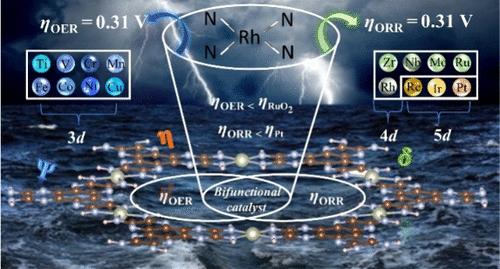用恒电位法研究二维金属-有机骨架中析氧/还原反应的高效双功能电催化剂
IF 3.9
2区 化学
Q2 CHEMISTRY, MULTIDISCIPLINARY
引用次数: 0
摘要
发展高活性、稳定、导电的氧还原反应(ORR)和氧析反应(OER)双功能催化剂对推进金属空气电池和燃料电池的发展至关重要。我们在这里深入探讨了一类二维(2D)金属有机骨架(mof)的OER和ORR性能,称为TM3(HADQ)2, Rh3(HADQ)2表现出有前途的双功能OER/ORR活性,OER和ORR的过电位均为0.31 V。利用d带中心(εd)和晶体轨道汉密尔顿族(COHP)研究了OER/ORR活性与催化剂电子结构的关系,发现TM3(HADQ)2的中心TM的基本d电子数(Ne)以及配体TM- n4和中间O原子的电负性是影响OER/ORR活性的主要原因。另外,通过恒电位法(CPM)和微动力学方法可以证明Rh3(HADQ)2为酸性OER/ORR双功能催化剂。Rh3(HADQ)2具有较高的耐毒性,是一种潜在的双功能催化剂。我们的研究有助于合理设计用于各种催化过程的sac,以及制造双功能、经济高效的氧电催化剂。本文章由计算机程序翻译,如有差异,请以英文原文为准。

Efficient Bifunctional Electrocatalysts for Oxygen Evolution/Reduction Reactions in Two-Dimensional Metal–Organic Frameworks by a Constant Potential Method
The evolution of bifunctional catalysts for the oxygen reduction reaction (ORR) and oxygen evolution reaction (OER) catalysts that are highly active, stable, and conductive is crucial for advancing metal-air batteries and fuel cells. We have here thoroughly explored the OER and ORR performance for a category of two-dimensional (2D) metal–organic frameworks (MOFs) called TM3(HADQ)2, and Rh3(HADQ)2 exhibits a promising bifunctional OER/ORR activity, with an overpotential of 0.31 V for both OER and ORR. The d-band center (εd) and crystal orbital Hamilton populations (COHP) are utilized to study the relationship between OER/ORR activity and the electronic structure of catalysts, and it is found that the elementary d-electron number (Ne) of the central TM for TM3(HADQ)2, as well as the electronegativity of the ligand TM-N4 and the intermediate O atom, are the main reason that affects the catalytic activity of OER/ORR. Additionally, Rh3(HADQ)2 can be proven through the constant potential method (CPM) and microkinetics method that it is an acidic OER/ORR bifunctional catalyst. Rh3(HADQ)2 has a high toxicity tolerance, making it a potential bifunctional catalyst. Our research contributes to both the rational design of SACs for various catalytic processes and the fabrication of bifunctional, cost-effective oxygen-electric catalysts.
求助全文
通过发布文献求助,成功后即可免费获取论文全文。
去求助
来源期刊

Langmuir
化学-材料科学:综合
CiteScore
6.50
自引率
10.30%
发文量
1464
审稿时长
2.1 months
期刊介绍:
Langmuir is an interdisciplinary journal publishing articles in the following subject categories:
Colloids: surfactants and self-assembly, dispersions, emulsions, foams
Interfaces: adsorption, reactions, films, forces
Biological Interfaces: biocolloids, biomolecular and biomimetic materials
Materials: nano- and mesostructured materials, polymers, gels, liquid crystals
Electrochemistry: interfacial charge transfer, charge transport, electrocatalysis, electrokinetic phenomena, bioelectrochemistry
Devices and Applications: sensors, fluidics, patterning, catalysis, photonic crystals
However, when high-impact, original work is submitted that does not fit within the above categories, decisions to accept or decline such papers will be based on one criteria: What Would Irving Do?
Langmuir ranks #2 in citations out of 136 journals in the category of Physical Chemistry with 113,157 total citations. The journal received an Impact Factor of 4.384*.
This journal is also indexed in the categories of Materials Science (ranked #1) and Multidisciplinary Chemistry (ranked #5).
 求助内容:
求助内容: 应助结果提醒方式:
应助结果提醒方式:


